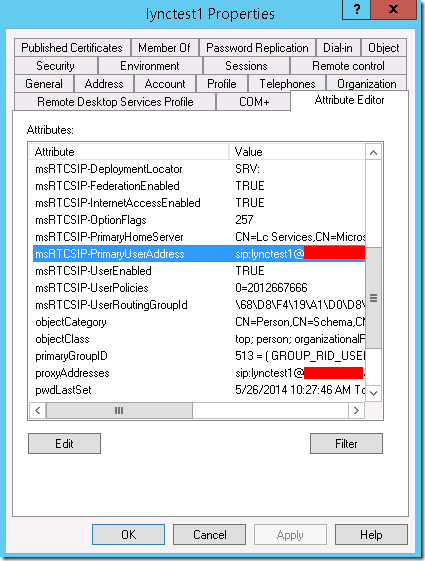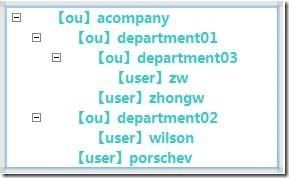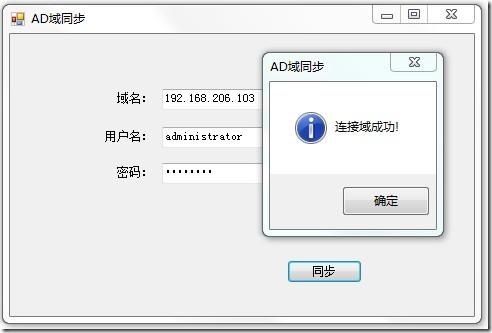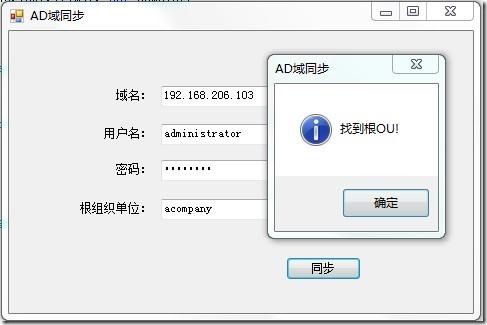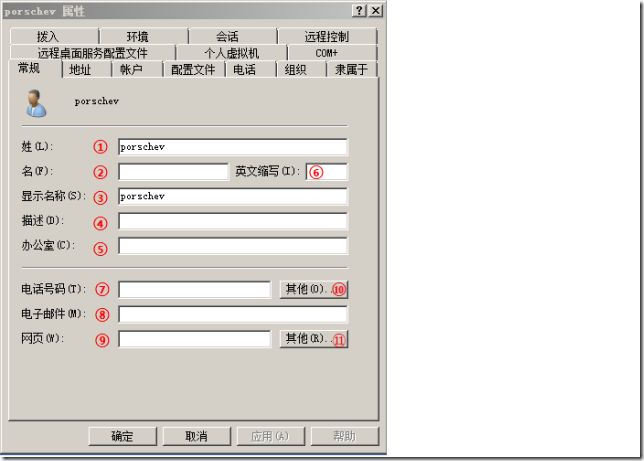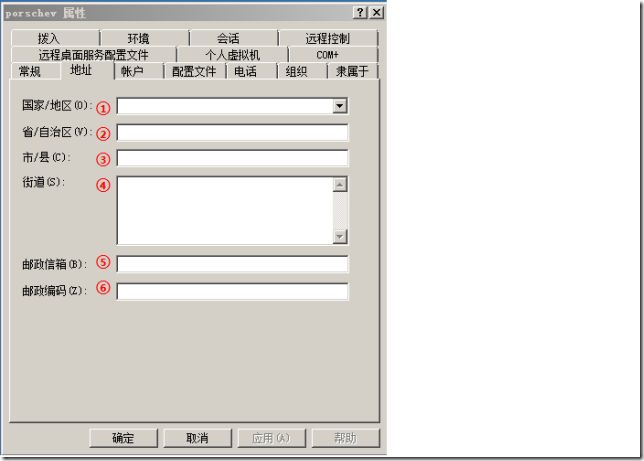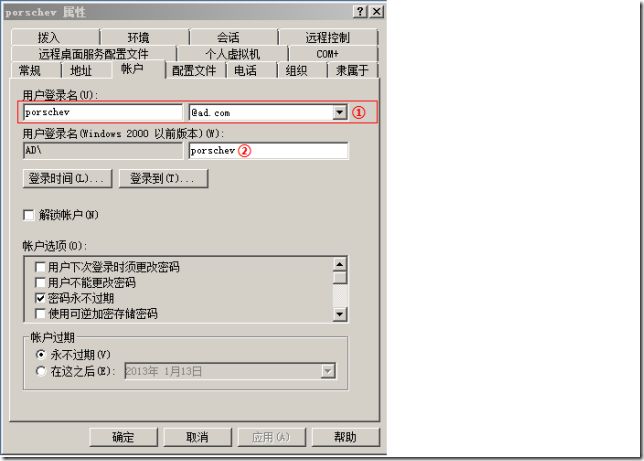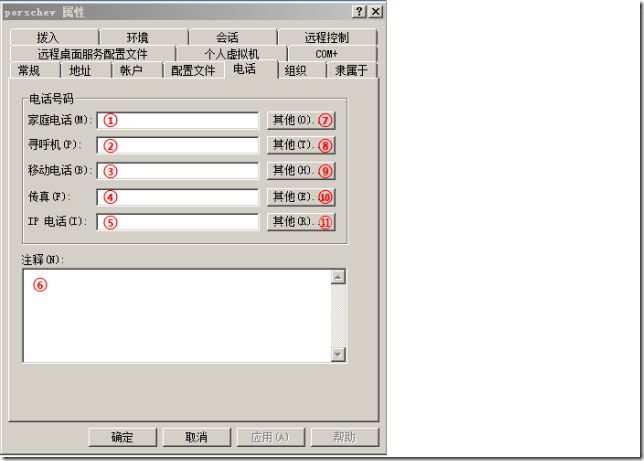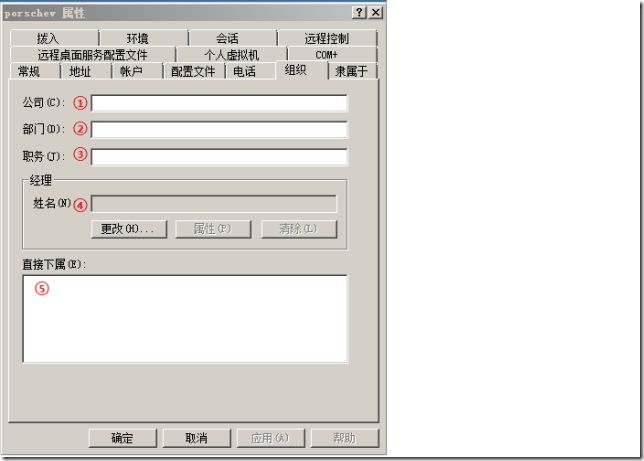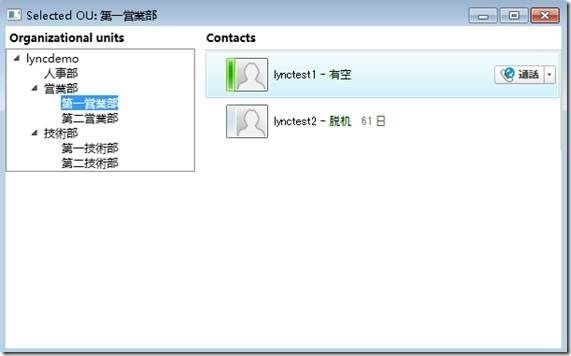这节我们来看看怎么让Lync从AD中同步组织架构。
在第1节中,我们知道了怎么在Lync中显示指定用户。那么如果我们稍微扩展下,只要我们能想办法读到AD中用户和OU的信息,再将其显示在Lync的窗口中,那么我们的目的就能达成了。
要显示出Lync用户,就要知道用户的Sip属性值,我们打开AD中的用户属性。
发现msRTCSIP-PrimaryUserAddress值是确定用户Lync的SIP值的属性。
知道了这点,那就想办法用C#来读取AD中用户这个属性吧。
关于C# AD(Active Directory)域信息同步,组织单位、用户等信息查询的代码,转帖如下:
http://www.cnblogs.com/zhongweiv/archive/2013/01/05/ad_sync.html
###############################################################
C# AD(Active Directory)域信息同步,组织单位、用户等信息查询
接上篇 Windows Server 2008 R2 配置AD(Active Directory)域控制器
对AD域结合常见需求用C#进行一些读取信息的操作^_^!
目录 |
· 示例准备
· 知识了解
· 读取AD域信息示例
· DirectorySearcher.Filter属性扩充说明
· 用户属性扩充说明(含图文属性对照)
· 常规
· 地址
· 帐户
· 电话
· 组织
· 示例下载
示例准备 |
· 打开上一篇文章配置好的AD域控制器
· 开始菜单-->管理工具-->Active Directory 用户和计算机
· 新建组织单位和用户
· 新建层次关系如下:
知识了解 |
我们要用C#访问Active Directory非常容易,主要用到
轻量目录访问协议 (LDAP)
System.DirectoryServices命名空间下的两个组件类
DirectoryEntry和DirectorySeacher
读取AD域信息示例 |
示例在Framework 3.5下用Winform程序编写
主要结合常见需求读取组织单位(OU)及用户(User)信息,以及同步组织单位和用户的层次关系;
比较着重的还是用户的信息,特别是帐号、邮箱、SID等信息;
· 下面我们开始连接域,并读取出示例准备中键好的组织单位和用户
首先编写代码用LDAP尝试对域进行访问
形式:LDAP://Domain
![]()
#region## 是否连接到域
///
/// 功能:是否连接到域
/// 作者:Wilson
/// 时间:2012-12-15
/// http://msdn.microsoft.com/zh-cn/library/system.directoryservices.directoryentry.path(v=vs.90).aspx
///
/// 域名或IP
/// 用户名
/// 密码
/// 域
///
private bool IsConnected(string domainName, string userName, string userPwd, out DirectoryEntry domain)
{
domain = new DirectoryEntry();
try
{
domain.Path = string.Format("LDAP://{0}", domainName);
domain.Username = userName;
domain.Password = userPwd;
domain.AuthenticationType = AuthenticationTypes.Secure;
domain.RefreshCache();
return true;
}
catch(Exception ex)
{
LogRecord.WriteLog("[IsConnected方法]错误信息:" + ex.Message);
return false;
}
}
#endregion
![]()
传用参数,调IsConnected方法,结果如下
· 连接上AD域后,接着我们找到根OU
![]()
#region## 域中是否存在组织单位
///
/// 功能:域中是否存在组织单位
/// 作者:Wilson
/// 时间:2012-12-15
///
///
///
///
private bool IsExistOU(DirectoryEntry entry, out DirectoryEntry ou)
{
ou = new DirectoryEntry();
try
{
ou = entry.Children.Find("OU=" + txtRootOU.Text.Trim());
return (ou != null);
}
catch(Exception ex)
{
LogRecord.WriteLog("[IsExistOU方法]错误信息:" + ex.Message);
return false;
}
}
#endregion
![]()
传入以数,调用IsExistOU方法,结果如下
· 下面来开始读取组织单位及用户的信息。
示例为了看出层次关系及导出信息是类型区分,给OU和User新建了一个实体类和一个类型的枚举
![]()
#region## 类型
///
/// 类型
///
public enum TypeEnum : int
{
///
/// 组织单位
///
OU = 1,
///
/// 用户
///
USER = 2
}
#endregion
#region## Ad域信息实体
///
/// Ad域信息实体
///
public class AdModel
{
public AdModel(string id, string name, int typeId, string parentId)
{
Id = id;
Name = name;
TypeId = typeId;
ParentId = parentId;
}
public string Id { get; set; }
public string Name { get; set; }
public int TypeId { get; set; }
public string ParentId { get; set; }
}
#endregion
![]()
下面读取信息
![]()
private List
#region## 同步
///
/// 功能:同步
/// 创建人:Wilson
/// 创建时间:2012-12-15
///
///
public void SyncAll(DirectoryEntry entryOU)
{
DirectorySearcher mySearcher = new DirectorySearcher(entryOU, "(objectclass=organizationalUnit)"); //查询组织单位
DirectoryEntry root = mySearcher.SearchRoot; //查找根OU
SyncRootOU(root);
StringBuilder sb = new StringBuilder();
sb.Append("\r\nID\t帐号\t类型\t父ID\r\n");
foreach (var item in list)
{
sb.AppendFormat("{0}\t{1}\t{2}\t{3}\r\n", item.Id, item.Name, item.TypeId, item.ParentId);
}
LogRecord.WriteLog(sb.ToString());
MessageBox.Show("同步成功", this.Text, MessageBoxButtons.OK, MessageBoxIcon.Information);
Application.Exit();
}
#endregion
#region## 同步根组织单位
///
/// 功能: 同步根组织单位
/// 创建人:Wilson
/// 创建时间:2012-12-15
///
///
private void SyncRootOU(DirectoryEntry entry)
{
if (entry.Properties.Contains("ou") && entry.Properties.Contains("objectGUID"))
{
string rootOuName = entry.Properties["ou"][0].ToString();
byte[] bGUID = entry.Properties["objectGUID"][0] as byte[];
string id = BitConverter.ToString(bGUID);
list.Add(new AdModel(id, rootOuName, (int)TypeEnum.OU, "0"));
SyncSubOU(entry, id);
}
}
#endregion
#region## 同步下属组织单位及下属用户
///
/// 功能: 同步下属组织单位及下属用户
/// 创建人:Wilson
/// 创建时间:2012-12-15
///
///
///
private void SyncSubOU(DirectoryEntry entry, string parentId)
{
foreach (DirectoryEntry subEntry in entry.Children)
{
string entrySchemaClsName = subEntry.SchemaClassName;
string[] arr = subEntry.Name.Split('=');
string categoryStr = arr[0];
string nameStr = arr[1];
string id = string.Empty;
if (subEntry.Properties.Contains("objectGUID")) //SID
{
byte[] bGUID = subEntry.Properties["objectGUID"][0] as byte[];
id = BitConverter.ToString(bGUID);
}
bool isExist = list.Exists(d => d.Id == id);
switch (entrySchemaClsName)
{
case "organizationalUnit":
if (!isExist)
{
list.Add(new AdModel(id, nameStr, (int)TypeEnum.OU, parentId));
}
SyncSubOU(subEntry, id);
break;
case "user":
string accountName = string.Empty;
if (subEntry.Properties.Contains("samaccountName"))
{
accountName = subEntry.Properties["samaccountName"][0].ToString();
}
if (!isExist)
{
list.Add(new AdModel(id, accountName, (int)TypeEnum.USER, parentId));
}
break;
}
}
}
#endregion
![]()
调用SyncAll方法循环输出list,结果如下,很清楚的可以看出层次关系
![]()
//ID 帐号 类型 父ID
//58-D6-C4-32-6A-A1-99-48-A4-8B-C8-5D-BC-C9-3E-17 acompany 1 0
//FB-44-91-AE-AC-73-2B-4D-9F-01-B1-E2-16-D3-CB-1B department01 1 58-D6-C4-32-6A-A1-99-48-A4-8B-C8-5D-BC-C9-3E-17
//47-9D-5B-91-60-22-D1-46-B0-CD-C7-B2-C7-D3-00-31 department03 1 FB-44-91-AE-AC-73-2B-4D-9F-01-B1-E2-16-D3-CB-1B
//E3-AD-47-45-38-64-02-4D-B9-83-2C-50-67-50-4F-92 zw 2 47-9D-5B-91-60-22-D1-46-B0-CD-C7-B2-C7-D3-00-31
//8A-D4-23-18-F3-6F-E1-47-93-7A-CC-07-76-4B-E7-86 zhongw 2 FB-44-91-AE-AC-73-2B-4D-9F-01-B1-E2-16-D3-CB-1B
//BC-D0-34-85-67-2F-05-4D-B5-77-E3-F4-AD-51-45-02 department02 1 58-D6-C4-32-6A-A1-99-48-A4-8B-C8-5D-BC-C9-3E-17
//1C-13-FA-66-E4-51-65-49-8B-DC-22-60-32-34-8F-22 wilson 2 BC-D0-34-85-67-2F-05-4D-B5-77-E3-F4-AD-51-45-02
//84-E8-E5-9A-6B-56-E2-45-9A-87-54-D1-78-6B-D3-56 porschev 2 58-D6-C4-32-6A-A1-99-48-A4-8B-C8-5D-BC-C9-3E-17
![]()
DirectorySearcher.Filter属性扩充说明 |
DirectorySearcher mySearcher = new DirectorySearcher(entryOU, "(objectclass=organizationalUnit)"); //查询组织单位
第二个参数是一个filter,也可以根据需求输入其它筛选条件,下面列出几个常用的
筛选条件 |
值 |
用户 |
(&(objectCategory=person)(objectClass=user)) |
计算机 |
(objectCategory=computer) |
组 |
(objectCategory=group) |
联系人 |
(objectCategory=contact) |
共享文件夹 |
(objectCategory=volume) |
打印机 |
(objectCategory=printQueue) |
更多高级筛选请查看:http://msdn.microsoft.com/zh-cn/library/system.directoryservices.directorysearcher.filter(v=vs.80).aspx
用户属性扩充说明(含图文属性对照) |
示例中只对用户进行了读取了几个属性,用过AD域的应该都知道,用户的属性较多也比较常用。
下面通过AD域的用户详细信来对照一下相应的属性名
· 常项选项卡
对应编号 |
选项卡对应项名 |
属性名 |
① |
姓(L) |
sn |
② |
名(F) |
givenName |
③ |
显示名称(S) |
displayName |
④ |
描述(D) |
description |
⑤ |
办公室(C) |
physicalDeliveryOfficeName |
⑥ |
英文缩写(I) |
initials |
⑦ |
电话号码(T) |
telephoneNumber |
⑧ |
电子邮件(M) |
|
⑨ |
网页(W) |
wWWHomePage |
⑩ |
电话号码-其它(O)... |
otherTelephone |
? |
网页-其它(R)... |
url |
· 地址选项卡
对应编号 |
选项卡对应项名 |
属性名 |
① |
国家/地区(O) |
co |
② |
省/自治区(V) |
st |
③ |
市/县(C) |
l |
④ |
街道(S) |
streetAddress |
⑤ |
邮政信箱(B) |
postOfficeBox |
⑥ |
邮政编码(Z) |
postalCode |
· 帐户选项卡
对应编号 |
选项卡对应项名 |
属性名 |
① |
用户登录名(U) |
userPrincipalName |
② |
用户登录名(Windows 2000 以前版本)(W) |
sAMAccountName |
· 电话选项卡
对应编号 |
选项卡对应项名 |
属性名 |
① |
家庭电话(M) |
homePhone |
② |
寻呼机(P) |
pager |
③ |
移动电话(B) |
mobile |
④ |
传真(F) |
facsimileTelephoneNumber |
⑤ |
IP电话(I) |
ipPhone |
⑥ |
注释 |
info |
⑦ |
家庭电话-其它(O) |
otherHomePhone |
⑧ |
寻呼机-其它(T) |
otherPager |
⑨ |
移动电话-其它(B) |
otherMobile |
⑩ |
传真-其它(E) |
otherFacsimileTelephoneNumber |
? |
IP电话-其它(R) |
otherIpPhone |
· 组织选项卡
对应编号 |
选项卡对应项名 |
属性名 |
① |
公司(C) |
company |
② |
部门(D) |
department |
③ |
职务(J) |
title |
④ |
经理-姓名(N) |
manager |
⑥ |
直接下属(E) |
directReports |
还有一些属性没有列出来,可以循环输出DirectoryEntry.Properties.PropertyNames来找
比如用objectsid这也是个用户比较重要的属性,在设置Windows共享时会用到!
示例下载 |
示例下载:http://files.cnblogs.com/zhongweiv/SynchronousAD.zip
示例代码,写得比较简陋,有需要就下载了将就着看一下吧^_^!
###############################################################
转帖结束。
只要我们把以上代码稍作修改,让DirectorySearcher读取用户msRTCSIP-PrimaryUserAddress属性值,并且用树形视图把OU层次显示出来,即可初步达到需求。
关于怎么启动这个同步工具可以参照第2节,在工具栏中做一个自定义菜单。
最后初步效果如下。
示例代码可见附件。
